![Product vs Marketing Analytics: What's The Difference [+Tools] cover](https://blog-static.userpilot.com/blog/wp-content/uploads/2023/08/product-vs-marketing-analytics-whats-the-difference_6b7c411dc991708f6b3f3c47cbe25b35_2000.png)
It’s common to struggle to understand the difference between product vs marketing analytics if you’re new to the concepts.
Both analytics types leverage data to increase conversion, drive product usage, and create better user experiences, but there are a few key differences.
This article shows how they differ and lists some of the best product and marketing analytics tools.
Try Userpilot Now
See Why 1,000+ Teams Choose Userpilot

Summary of product vs marketing analytics
- Product analytics is the process of collecting, measuring, and analyzing data about how users interact with your product.
- Marketing analytics involves using quantitative and qualitative data to evaluate the performance of various marketing strategies, campaigns, channels, and tactics.
The main differences:
- Product analytics offers insights into customer experience, while marketing analytics on demographics.
- Marketing analytics focuses on increasing ROI of acquisition campaigns, while product analytics is aimed at measuring and increasing product engagement and growth.
- Product analytics focuses on customer retention, while marketing analytics focuses on customer acquisition.
Product analytics tools:
- Userpilot – best analytics tool for product marketing and product teams.
- Mixpanel – best product tool for website analytics.
Marketing analytics tools:
- Google Analytics – best for tracking the performance of your marketing strategies and campaigns.
- Hubspot – best for enterprise marketing and sales teams.
Are you tracking the metrics that actually drive growth?
Marketing gets them to the door, but Product keeps them there. Take this 4-step assessment to see if you have the right balance of product vs marketing analytics.
What is product analytics?
Product analytics is the process of collecting, measuring, and analyzing data about how users interact with your product.
It’s used to understand user behavior, identify areas for improvement, and make data-driven decisions about the product.
What is marketing analytics?
It involves using quantitative and qualitative data to evaluate the performance of various marketing strategies, campaigns, channels, and tactics.
Marketing analytics provides valuable insights into buyer behavior, audience engagement, and the impact of marketing activities on business outcomes. This allows marketing folks to make data-driven decisions that optimize marketing strategies and drive business growth.
Product vs marketing analytics: What are the main differences?
High-level overview: Product analytics kicks in once a lead becomes a user of the product. It focuses on making users enjoy the product experience.
On the other hand, marketing analytics is aimed at the marketing process. The goal is to acquire new users and drive sales.
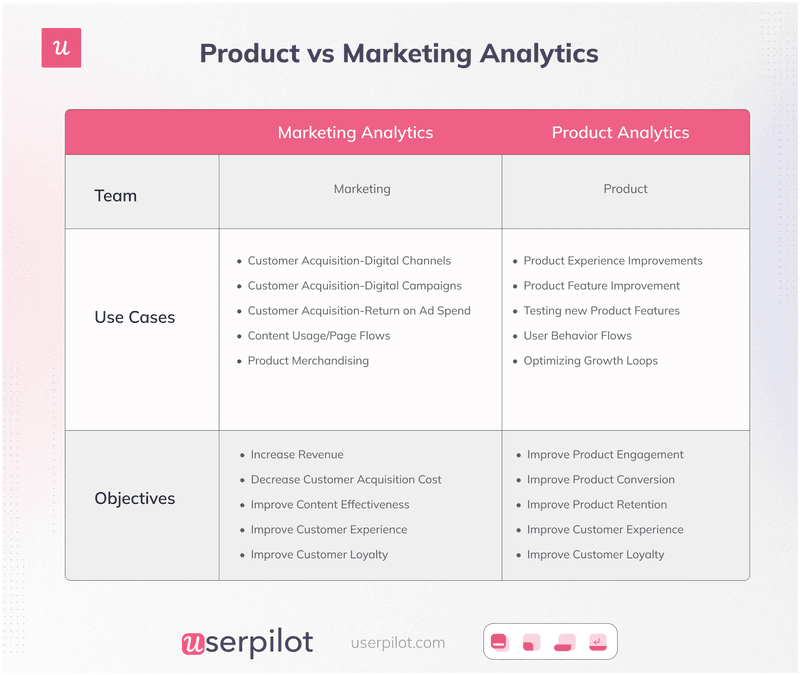
Let’s get into some details:
Product analytics offers insights into customer experience while marketing analytics on demographics
With product analytics, you’ll see how users interact with your product—the features they use, how long they spend on each page, where they drop off, etc.
On the other hand, marketing analytics lets you understand who your customers are, where they come from, and what marketing channels they respond to.
By tapping into both types of analytics, you can get a bird’s-eye view of your audience and how to enhance the customer experience.
Product analytics focuses on increasing product engagement, while marketing analytics focuses on increasing ROI
Both activities ultimately contribute to more revenue but in different ways.
With product analytics, you’ll understand product usage patterns and trends, then determine the best ways to improve the customer experience based on data.
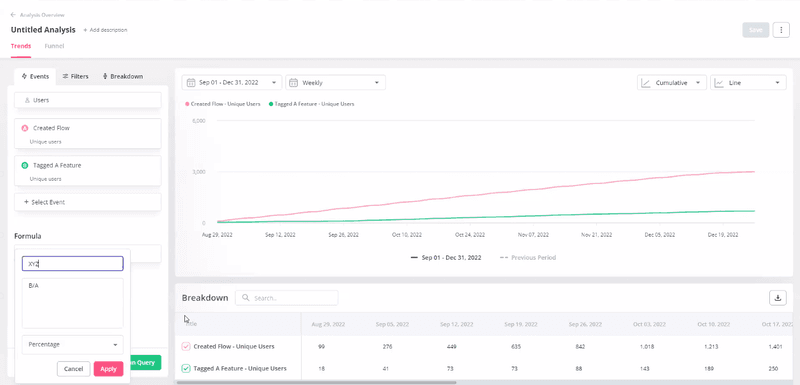
For example, if you know only 1℅ of your users regularly interact with a particular feature, you might consider removing it to focus on more popular features. Another example: through product analytics, you can see where trial users are dropping off and why. By addressing the issue, you’ll improve your conversion rate and boost revenue.
How does marketing analytics data help you increase ROI?
You can use it to identify and focus on high-performing marketing channels and strategies. For example, if the data shows social media is the most effective channel for acquiring new customers, you can decide to focus more on that and get more value for your money and efforts.
Product analytics focuses on customer retention, while marketing analytics focuses on customer acquisition
As hinted earlier, marketing analytics takes the helm during the initial stages of the customer journey, where awareness and consideration are paramount.
For a web app, marketing analytics would track how many prospects have been reached with the latest marketing activities and how many have downloaded the app.
Product analytics focuses on the later stages of the user journey. In this case, product analytics tracks the percentage of newly acquired users that keep returning to the platform, the paths they take when using the tool, and why other users are churning.
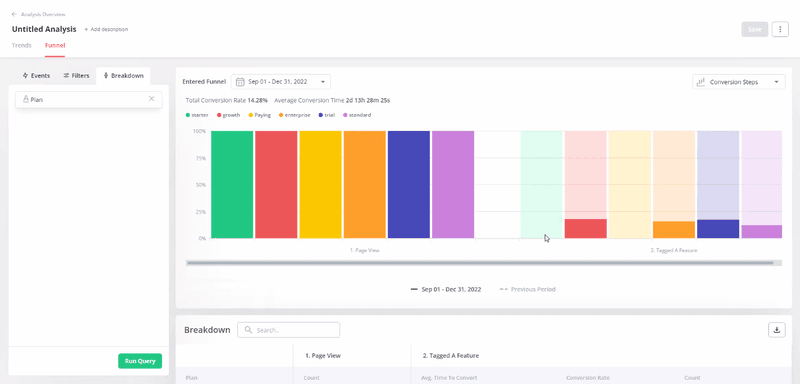
Best product analytics tools for product teams
Any product analytics tool worth its onions should at least let you do the following:
- Track in-app user behavior
- Define and track custom events specific to your product’s unique features and user actions
- Segment users based on particular attributes or behavior
- Identify the user journey and drop off points through funnel analysis
- A/B testing or at least the ability to let you integrate with A/B testing tools
Userpilot and Mixpanel are two product analytics software that pass the test. Below is a closer look at their features:
Userpilot – best analytics tool for product marketing and product teams
Userpilot enables product teams to track user behavior at every customer journey stage. With our platform, you can gain insights into metrics around feature adoption, new user activation, user sentiment, and support portal usage.
How?
- Event tracking: Single action tracking won’t always give you the whole picture. For instance, customer activation involves multiple steps, and you’ll need granular insights into user behavior through all the steps to properly understand what’s happening. Userpilot’s Events feature comes to the rescue. It lets you group distinct actions and track them as one. The best part? You don’t need to write a line of code.
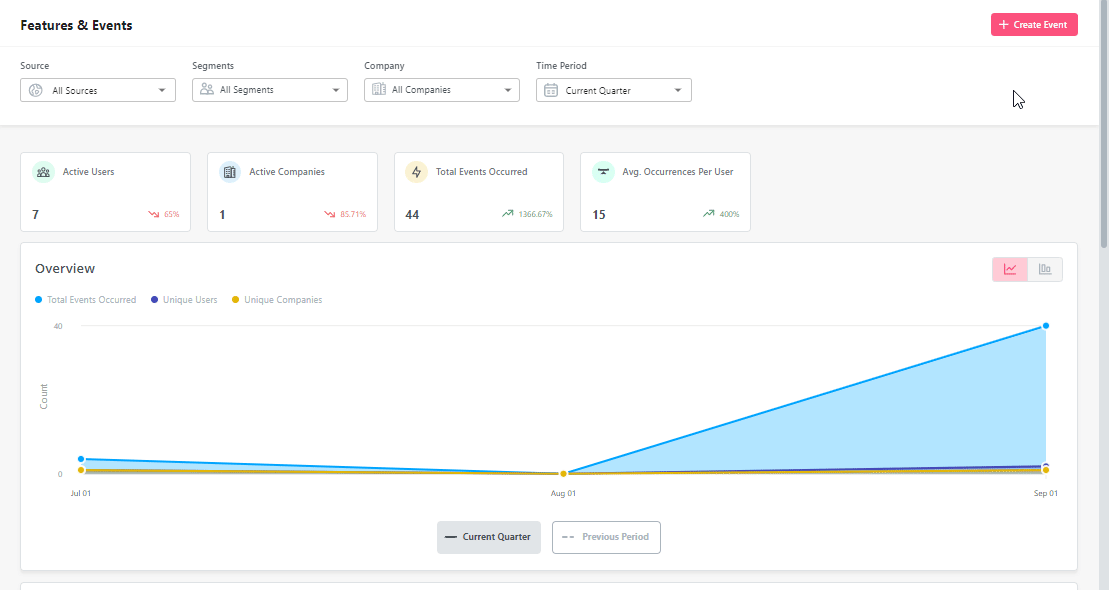
- Trends and funnels: This analysis feature allows you to visualize and analyze user steps within your product.
Using funnels you’ll identify common drop-off points and uncover insights into user behavior as they navigate through your product’s features and functionalities.
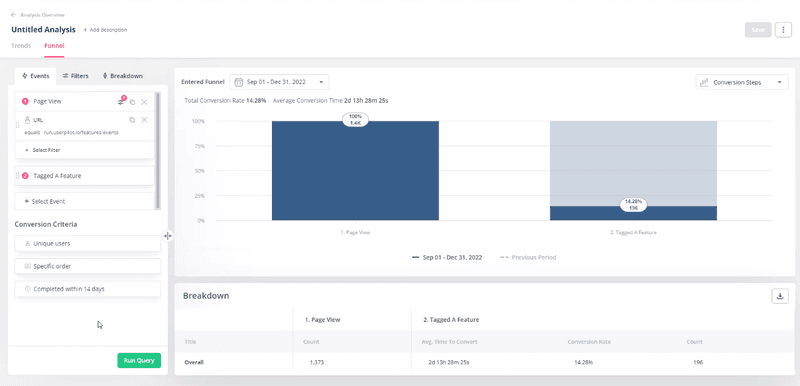
Mixpanel – best product analytics tool for web analytics
Mixpanel’s prowess lies in its ability to source and dissect vast collections of user data. This functionality makes it a valuable tool for large companies with many data analytics needs.
The platform allows you to track user behavior in a few clicks and segment customers or perform cohort analysis to get a granular understanding of their behavior. You can also perform group analysis to get an account or company-level engagement data.
While Mixpanel offers powerful analytics capabilities, it’s important to be aware of potential complexities and limitations.
The tool may be better suited for users with a certain level of technical proficiency and a willingness to invest time in its setup and configuration.
For example, users are required to define every event before capturing it, which can be hard to implement. Also, creating reports in Mixpanel is a time-consuming process as users need to invest considerable effort to set up reports tailored to their specific needs and goals.
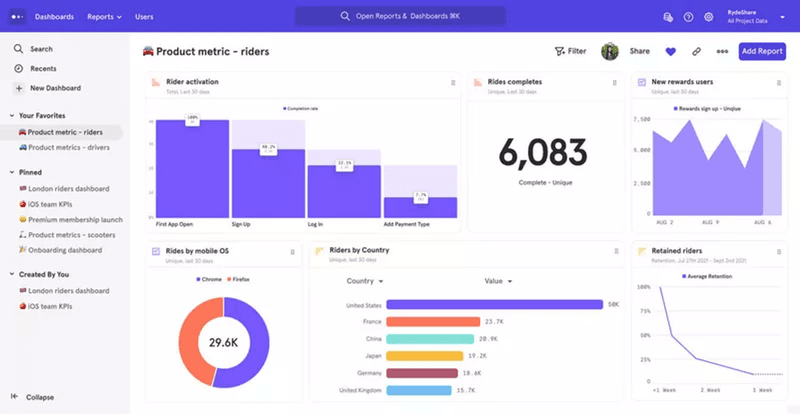
Best marketing analytics tools for marketing teams
Marketing analytics tools come in different categories, so the functionalities can vary greatly. However, any marketing analytics tool you choose should allow you to do common stuff like access real-time user insights and A/B test different marketing channels and campaigns.
Google Analytics – best for tracking the performance of your marketing campaigns
Google Analytics is a widely used website analytics tool. The platform enables businesses to track and analyze various aspects of their website’s performance, user behavior, and marketing efforts.
Through its custom reports and goal-setting features, GA offers valuable insights to help you measure the effectiveness of marketing efforts. This makes it easy to make data-driven decisions and optimize marketing campaigns. The reports let you see where your website traffic is coming from. You can analyze which channels drive the most visitors and conversions, helping you allocate resources effectively.
Additionally, Google Analytics allows you to perform goal funnel and behavior flow analysis to understand the path users take through your website.
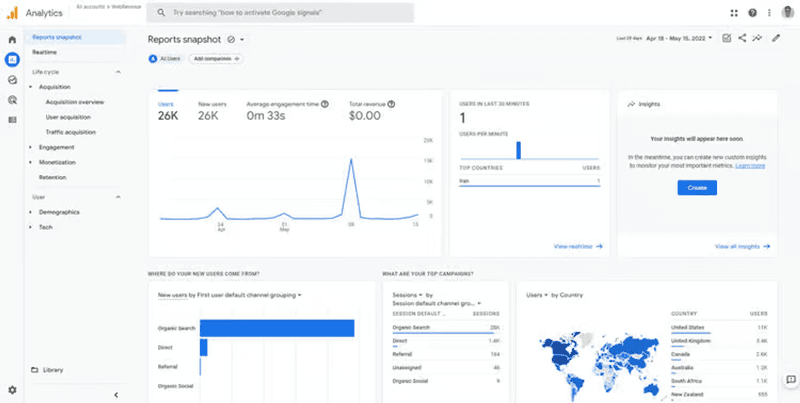
Hubspot – best for enterprise marketing and sales teams
HubSpot is a comprehensive marketing, sales, and customer service platform with a suite of tools designed to empower businesses in their marketing efforts.
The platform’s marketing analytics provide in-depth insights into the performance of marketing strategies, website traffic, content engagement, and lead generation efforts. You can track metrics like traffic sources, conversion rates, and customer acquisition costs to measure the effectiveness of marketing initiatives.
Userpilot seamlessly integrates with Hubspot to enable you to create engaging in-app experiences and drive retention. For example, you could utilize Userpilot to track user behavior and use Hubspot to score users based on their activities (Userpilot and Hubspot have a bi-directional integration too). This way, you’ll easily assign at-risk customers to the appropriate teams, follow up on users ripe for account expansion, etc.
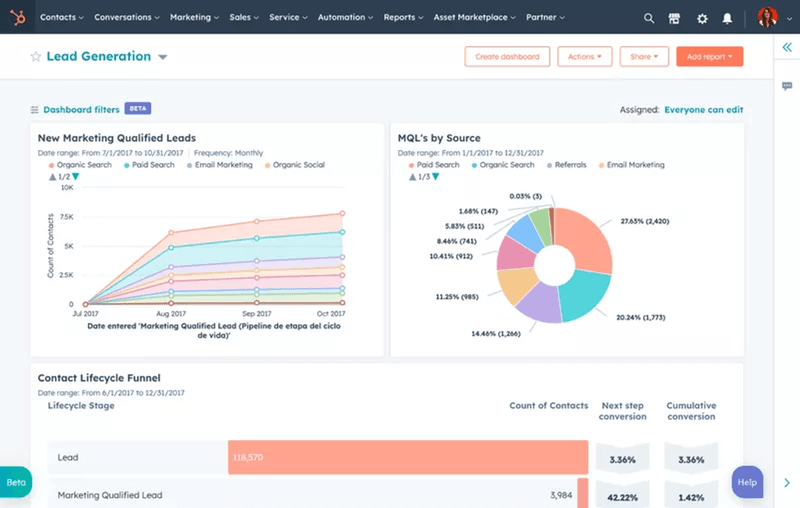
Conclusion
Don’t stop at knowing the difference between product vs marketing analytics. Begin implementing both disciplines and start reaping the benefits.
By combining marketing and product analytics, you can identify opportunities to enhance user satisfaction, tailor marketing campaigns based on user behavior, and iterate on product features that drive higher conversion rates and customer loyalty.
Userpilot can help. We’ll enable you to track product metrics while you use our integrations to analyze your marketing efforts. Book a demo call with our team and discuss your needs.







